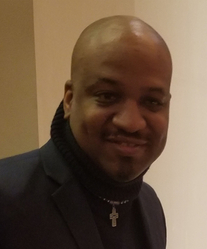photo courtesy of EJUSA/Ron Holtz Studio
Forty-seven-year-old Al-Tariq Best, founder and executive director of the HUBB, an arts and healing organization for youth, recalls the rage, humiliation and fear he felt as a 17-year-old when he and three other Black friends were pulled over by police in Newark, N.J.

“[There were] all these people around us. They search the car. They strip the car down. They make us pull our pants down in broad daylight. And I'm, I'm upset. And I'm questioning the police officer, like, what did we do? Why are you doing this? We're law-abiding citizens! And the cop is saying to me, ‘Oh, you think you’re a tough guy!’ And he pulled his gun out. And he put his gun to my head. And he was like, ‘Oh, you ain't so tough now!’ And I remember tears falling from my eyes,” says Best, choking back tears at the memory.
The policeman who held the gun to his head was white, but his partner was black. “And the black cop didn't do nothing to save me, to help. He just allowed it to happen,” says Best, still perplexed. Equally galling to Best at the time was that he was not a troublemaker. “I’m a straight-A student, I’m the one who’s doing everything by the book!”
Best’s experience of police brutality as a black teenager in the United States is yet another of countless examples, the most notable recently being the death of George Floyd, which was captured on video and sparked worldwide protests. The protests have led to widespread calls for radical changes in policing that includes defunding police forces to shift funds to social services to address domestic violence and homelessness, and changing police practices that unfairly target Black and LatinX people.
A little known pilot program in Newark, NJ, developed by Equal Justice USA, is experimenting with implementing some of these changes in policing. The program, known as Trauma to Trust, brings community members and police officers together in conversations about racial trauma, violence, and the police. The idea is that by fostering mutual understanding, they can reduce the incidence of aggressive policing and use of force. In each session, the participants go through a messy yet necessary process, organizers say, that can include emotionally charged interactions. The 16-hour training over two days began in 2016 and has trained 241 members out of 1,100 police officers of the Newark Police Department and 335 community members. Trauma to Trust includes learning about historical trauma, racial trauma and the Adverse Childhood Experiences (ACEs) Study.
The CDC/Kaiser Permanente Adverse Childhood Experiences Study (ACE Study) is the landmark study of 17,000 adults that found a relationship between 10 types of childhood traumas, such as living with an alcoholic or depressed parent or experiencing abuse or neglect, and the adult-onset of chronic illness, violence or being a victim of violence. Many other types of ACEs — including racism, bullying, a father being abused, and community violence — have been added to subsequent ACE surveys. (ACEs Science 101; Got Your ACE/Resilience Score?)
The ACE surveys — the epidemiology of childhood adversity — are one of five parts of ACEs science, which also includes how toxic stress from ACEs affects children’s brains, the short- and long-term health effects of toxic stress, how toxic stress is passed on from generation to generation, and research on resilience, which includes how individuals, organizations, systems and communities can integrate ACEs science to solve our most intractable problems.
The findings of a 2011 Department of Justice investigation of the Newark Police Department bolster the reality that the recent protests have brought into stark view: that Blacks are more likely than Whites to experience some kind of trauma in relation to the police. The investigation found while Blacks comprise 53% of the Newark population, they accounted for 85% of incidents in which residents were stopped by police, and 79 percent of arrests. It also found a pattern of unconstitutional arrests, “for behavior perceived as insubordinate or disrespectful to officers – often charged as obstruction of justice, resisting arrest or disorderly conduct,” according to the report.

Equal Justice USA Executive Director Shari Silberstein says that one of the main points of the training is to deal with such misperceptions. “A lot of symptoms of trauma are things that are interpreted as something else,” she says. “Hypervigilance and aggression—they get interpreted as resisting arrest.”
The investigation also concluded that “more than 20 percent of the NPD officers’ reported use of force [was found] to be unreasonable and in violation of the Constitution. These and other findings led to a federal Consent Decree in 2016, which is an agreement between the Department of Justice and the City of Newark, to enact reforms such as removing bias, implementing changes in policy and practice around use of force, and developing tools that ensure accountability.
In September 2016, 30 years after Al-Tariq-Best’s harrowing encounter with police, he made his way over to the Newark Police Department to participate in the Trauma to Trust program. He had been invited to participate by Equal Justice USA. However, just minutes after Best stepped inside, he felt an overwhelming desire to turn on his heels and flee.
“I had seen all of these police officers in there,” he recalls. “And I was like, I'm not doing this. And, and I turned around, and I was walking out the door. And Fatima [one of the trainers with Equal Justice USA] actually came and grabbed me. And she pulled me back and was like, you know, I really need you to go through this. And she asked me what was going on? Why was I leaving? And I was like, I'm not sitting here with all these police officers. And she was like, talk to me. Tell me about that. So now, before the class even starts, we're getting into a whole conversation about what happened to me. And in it, you got a few cops who are saying, ‘Well, what was you doing?!’ And they're judging me. So, it got really heavy in there, like we argue and we going back and forth and I'm like your job is to protect and serve! “
But as the heat was rising in the room, another police officer stood up and started to talk. “And it's crazy,” Best says. “I don't even know his name, and he apologized for what had happened to me when I was 17. All this time, all I ever needed was an apology. That's all I needed. Because my walls came crashing down once I heard the apology, and I was able to hear what the police officers were saying.”
The police officer’s apology captures a central tenet of Trauma to Trust, which involves shifting perspective from, “What’s wrong with you?” to “What’s happened to you?” And it’s why the training program has a lot of charged interactions. “A lot of what we do is to move towards conversations where people are more vulnerable, are able to tap into their empathy, their own pain, so they can see the pain of others,” says Silberstein. “And that’s very different from what normally happens in a police department,” which Silberstein characterizes as behaviors more akin to a culture of “macho militarization.”
In addition to teaching about the ACE Study, the Trauma to Trust training includes deep dives into historical trauma, using a video entitled “From Slavery to Mass Incarceration,”which was created by the Equal Justice Initiative. The Initiative was founded by civil rights attorney Bryan Stephenson, whose work was captured in the book and the feature film “Just Mercy.” The training also provides grounding techniques, such as directing a person to notice five things in the room that are red; a video about how police officers experience trauma on the job; training for police in how to interact with trauma survivors and provide them with community resources; and how trauma shows up among people of color and members of the LGBTQ community.
The curriculum for the training was developed collaboratively by Equal Justice USA, The New Jersey chapter of the Association of Black Psychologists, a violence prevention program known as the Newark Community Street Team, and an advisory group that includes survivors of violence, former police officers and community advocates. The trauma portion of the training was based on training for law enforcement developed by the Substance Abuse and Mental Health Services Administration (SAMHSA), with some changes to facilitate interaction between the police and the community.
Newark Police Division Captain Brian O’Hara was among the first members of the police force to take the Trauma to Trust training in 2016, and he has overseen the force’s involvement in the program as well as its work on fulfilling the requirements of the consent decree, as the commander of the Consent Decree & Planning Division. As part of that effort, the department set up an investigative unit and review board to handle citizens’ complaints about use of force, added some much-needed new officers, and underwent a separate training on “stop, search, and arrest.” O’Hara was particularly complimentary about how the Trauma to Trust training fostered communication between the police and community members.
“It was kind of like people being together, having those difficult conversations that people don’t like to have, and by the end of it having some shared sense of humanity and understanding. [People were] able to see that just like officers experience things that aren’t normal in certain ways that may affect them, the same is true with folks in the community. Discussion around historical trauma and experiences helps bring that humanity out.”
He sees a lot of overlap in the goals of the Trauma to Trust program and the provisions of the consent decree. For example, he believes that the training around racism and trauma has changed the way that police understand behaviors among Black residents. “I think there’s no doubt that it has,” he says. And since the DOJ investigation and the establishment of the use of force investigative unit, excessive use of force complaints dropped from 89 in 2010 to 21 in 2019, according to O’Hara. In 2020, there have been 14 excessive force complaints to date. (Here’s a link to reports on the progress of the consent decree.)
Equal Justice USA has no formal reports on the Trauma to Trust program, but an infographic provides some results of the first year of the pilot.
Among the findings: 14 out 15 participants said the training “increased understanding.” Twelve out of 15 “provided immediate trauma support to survivors instead of just telling them to ‘calm down.’” A month after the training, eight out of 10 officers had referred survivors to services.
And in a written evaluation of the program, one member of law enforcement said, “I need to approach the underlying issue and not retraumatize [the person]. [I have a] better understanding of historical and past trauma.”
One community member notes: “When we first came to class, people and officers didn’t want to talk, but by the third class, it was like we were friends.”
For his part, Al-Tariq Best says that the Trauma-to-Trust program has helped him reach across that divide to police in ways he never could have imagined before. “I’m able to have a relationship with a police officer,” he says, saying that two officers from the training have become good friends. He’s also able to better counsel young black boys and girls about how to interact with police. And he’s in the process of building a trauma-recovery center for youth adjacent to his non-profit The Hubb.
Reflecting back on the first day of the Trauma to Trust training, he says, “If I wouldn’t have stayed, I wouldn’t be doing the stuff that I’m doing today.”



Comments (0)